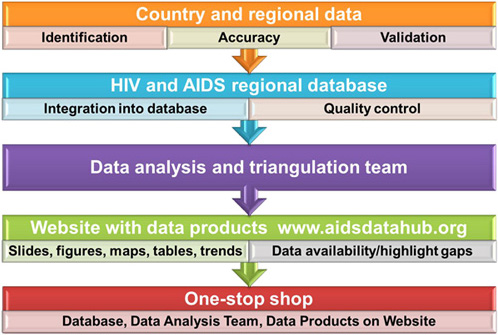A one-stop-shop for HIV and AIDS data in Asia and the Pacific
The regional database, data analysis team, and web site with data products are three major aspects comprising the Data Hub.

Data are collected by scanning published literature and national HIV web sites, and from a network of country and regional partners. Data are vetted by the team for accuracy and valid methodology and conclusions before being included in the regional database.
The Data Hub regional database now has over 100 000 data points collected from over 1000 sources for 1500 indicators (June 2013). The team is developing an easy-to-use database, accessible to governments, the public, researchers, civil society, the United Nations and donors. Available and searchable on-line, the regional database contains data on HIV knowledge and vulnerability, risk behaviours, epidemiology, HIV and AIDS financing, the impact of the epidemic and responses to it.
The Data Hub team responds specifically to regional needs by compiling the epidemic and response-related data on Asian countries and Pacific Island Countries and Territories, and by data syntheses and analyses of the collected data to generate useful strategic information products. These include data sheets, overview in slides, maps and reviews organized by country or thematic area for advocacy and evidence-based responses to the HIV epidemic. The data products, which are readily available on the web site and downloadable are also increasingly commissioned through direct communications with partners.
The web portal is the only regional site of its kind, with a large repository of data on 26 countries. The Data Hub web site has a comprehensive online reference library with about 3000 downloadable references, including national strategic plans, surveillance reports, population-based surveys, tools and guidelines.
The Data Hub works to:
- collate, analyse, use and share HIV data at various levels (subnational, national, regional and global) and on all major indicators of HIV risk, HIV knowledge and vulnerability, prevalence, infection estimates, economics of AIDS and national responses in 24 Asian and 22 Pacific countries and territories, including data disaggregated by age and sex;
- post updated data on the Data Hub web site and disseminate it to over 3000 subscribers within the region through data alerts, e-Newsflash, RSS feeds and social networks Facebook and Twitter;
- collaborate with stakeholders to monitor the AIDS epidemic, identify data gaps, undertake analyses and generate further knowledge of new risks and trends;
- and increase coordination, share more and better data, identify data gaps and foster closer cooperation on HIV and AIDS in the region by establishing an “ecosystem” of partners that can mutually benefit from participating in and using the Data Hub.





